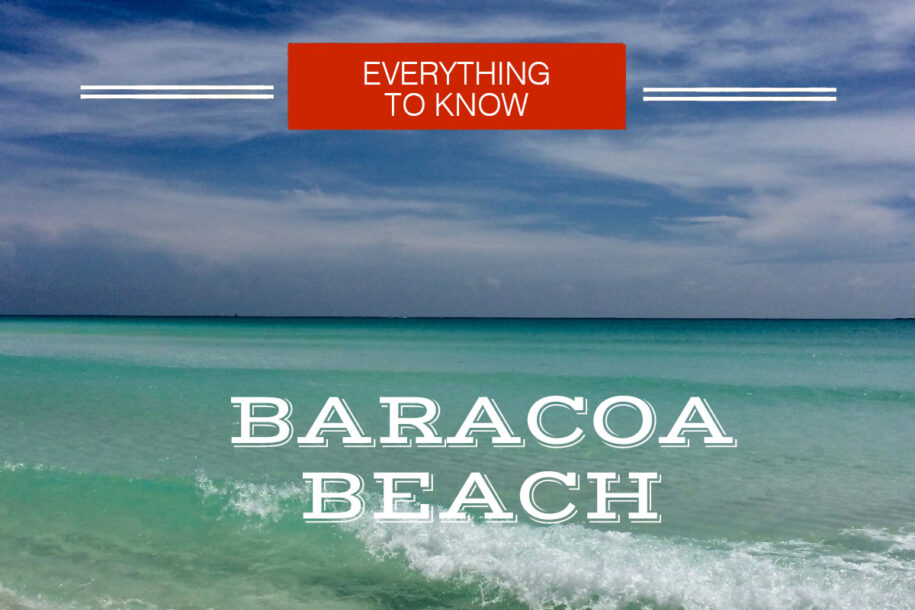![]()
There are some overland journeys that will be the adventure of a lifetime. Havana to Baracoa a 1000km 2 day drive along Carretera Central that runs the length of Cuba is one such trip. And here you’ll find beautiful Baracoa beach.
Or you could start your trip a little further west in the village of Le Fe in Pinar Del Rio and it’s some 1435 km (892 miles) before you arrive at Baracoa beach.
While Baracoa is not technically a hidden treasure, it’s not as well known as other beach towns in Cuba. This is not a bad thing either because it means you don’t need to share its beauty with so many other people. But what is it about Baracoa that makes it so special?
Standing on Baracoa Beach
There’s a sense of isolation when you stand on Baracoa beach and stare out over the ocean. It feels like you have found your own slice of Cuba that you don’t need to share with anyone else.
You are staring at the vast Atlantic Ocean across water that is more-or-less uninterrupted until you reach North Africa.
It looks like something out of a dream and the waters are so azure blue that it looks like a beautiful painting.
And always, always, the refreshing lack of crowds. Baracoa only has a permanent population of slightly over 80,000 and this does not increase very much, even in the peak summer months.
Remarkable History
Baracoa beach is a place of great historical significance as well. It is here that the first Spanish feet touched down on Cuban soil, led by a then little-known explorer named Christopher Columbus.
Yes, it was here that he first came to shore in Cuba on his voyage to the New World, ‘discovering’ lands that had already been inhabitated for millenia by the indigenous Taino peoples.
If you should need a rest from swimming and lazing on the sand (not that this will ever happen), it can be rather fascinating to sit by the harbor and imagine it as it was in 1492 when the Niña, the Pinta, and the Santa María sailed their way towards the coast.
Baracoa is also home to the Cruz de la Parra (the Cross of Vinewood), which is the original wooden cross erected by Columbus when he arrived in the area.
The Waterways
There are a huge number of rivers and streams that flow into the water on Baracoa beach, and it can be interesting to follow these waterways further inland.
It’s not wise to do this on your own, however, and you should consider joining a guided tour.
Most of these tours will take you through the gorgeous subtropical terrain as you follow the water through the hills.
The Toa River makes for the most interesting walk for a very good reason.
There are a number of waterfalls along the way, and you can swim through them in order to cool off!
As you make it further into the hills you will have a brilliant panoramic view over Baracoa beach, and of the town of Baracoa itself.
Take to the Water
Since Baracoa is a fairly isolated coastal town, much of the action (unsurprisingly) takes place on and around the water.
There is a yacht club in town, and you can inexpensively charter a boat that will take you on a scenic cruise along the coast, taking in a number of picturesque coves.
You can also rent a kayak to explore the rivers and streams. Be careful about taking your kayak into the open oceans.
While the tide is not as strong as it might be in other parts of the world, inexperienced kayakers might find the open water to be a bit too challenging.
Getting There
Baracoa beach used to only be accessible by boat, which is actually really rather a cool fact. This only came to an end in the late 1960s when a road was built through the mountains.
It’s possible to get to Baracoa by plane and bus or car though plane is the possibly the smart option. You land at the Gustavo Rizo Airport, some 4km (2.5 miles) out of town.
It’s a pretty small airport and so you can only get flights to and from Havana from there. There is no rail service to Baracoa, and given the mountainous terrain that surrounds the town, this is not likely to change any time soon.
Want to see Baracoa yourself? Check out our tours!
